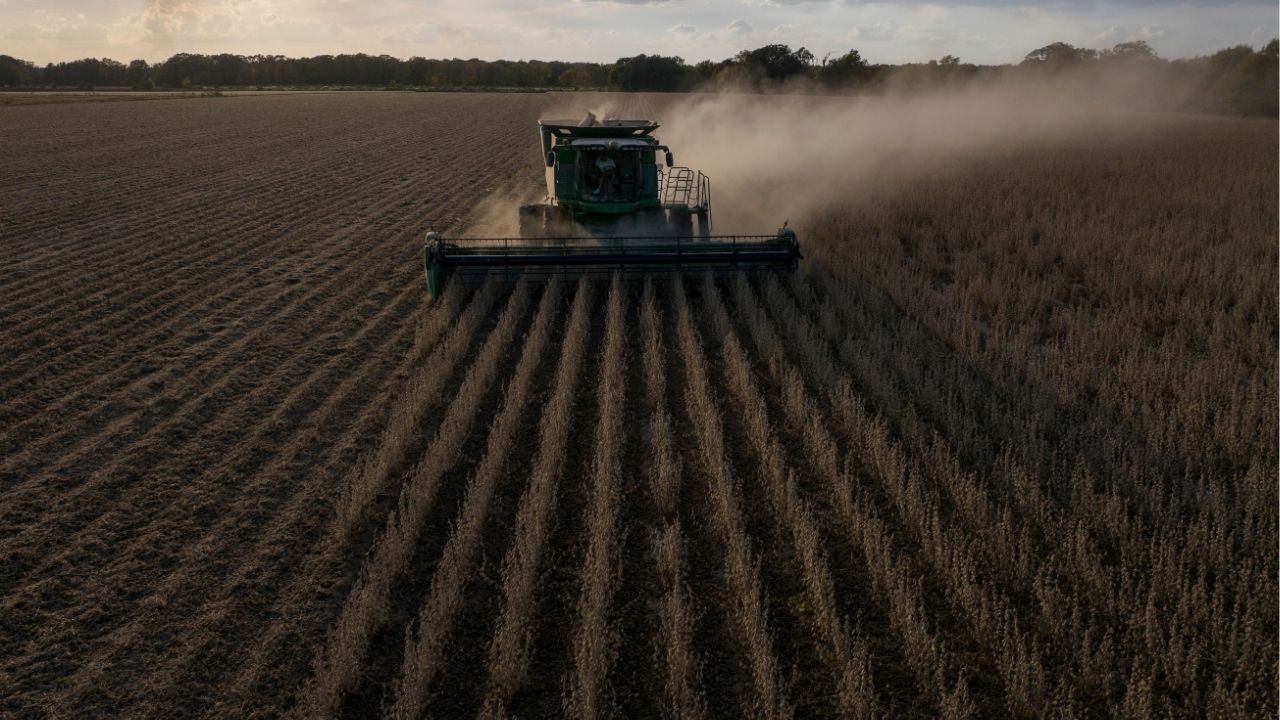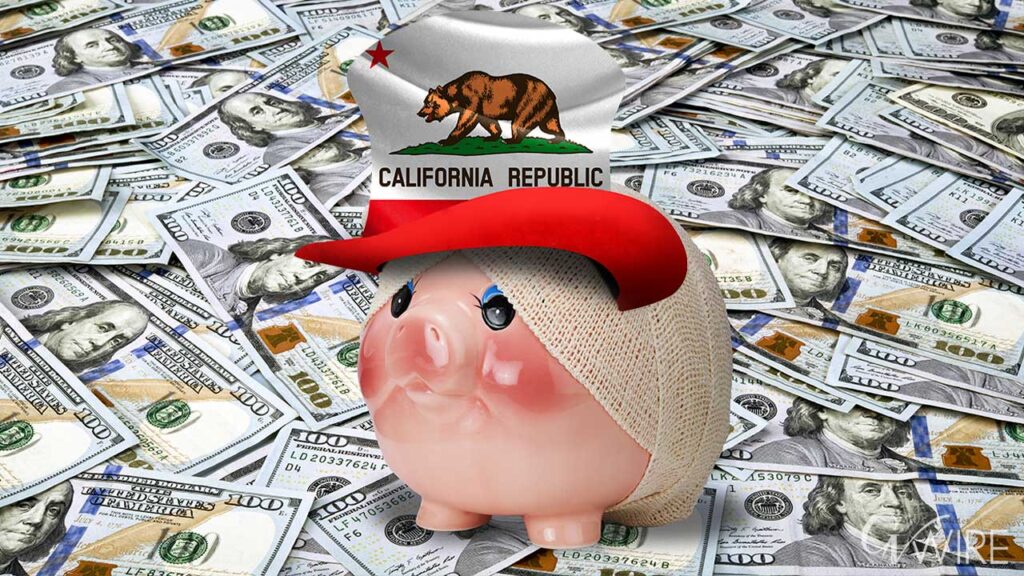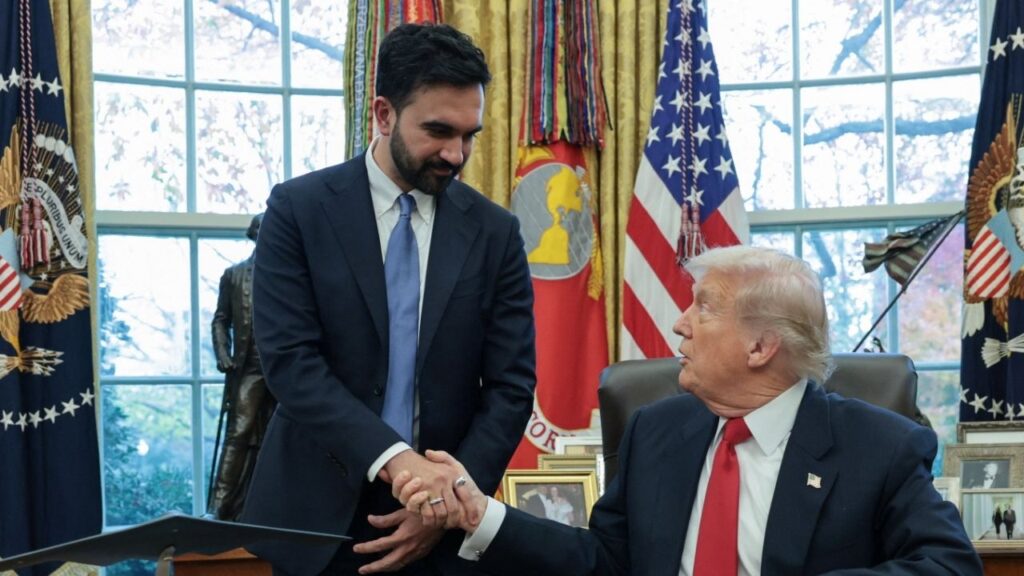Soybeans are harvested near Stuttgart, Ark., Oct. 25, 2023. Punishing tariffs on China, and painful retaliation. American farmers on the brink of bankruptcy. A multibillion-dollar bailout to keep farmers afloat. In 2025, it is 2018 all over again as the Trump administration prepares to address the same policy crisis it faced seven years ago. (Rory Doyle/The New York Times)
Share
|
Getting your Trinity Audio player ready...
|
WASHINGTON — Punishing Chinese tariffs that prompt painful retaliation. American farmers on the brink of bankruptcy. A multibillion-dollar bailout to keep farmers afloat.
It is 2018 all over again as the Trump administration prepares to address the same policy crisis it faced seven years ago when President Donald Trump, who imposed stiff tariffs on Chinese imports, had to shield the U.S. agriculture industry from the fallout of his trade war.
Trump has once again hit China with tariffs in his second term, eliciting the same economically painful retaliation by Beijing. As a result, the Trump administration is expected to unveil another round of economic support for farmers as soon as Tuesday. The scale and mechanics of the bailout remain unclear, but the crisis is even more urgent as China, the biggest buyer of American farm products, has drastically scaled back purchases of U.S. crops this year.
“I’m going to do some farm stuff this week,” Trump said at the White House on Monday.
Limits of Trump’s Trade Agenda
The need for federal farm aid demonstrates the limits of Trump’s trade agenda, which relies on tariffs to gain leverage in trade negotiations that are intended to open up markets to U.S. exports. Instead, the tariffs have pushed up costs for American farmers, who are facing higher prices for fertilizer and equipment. At the same time, they have lost their biggest customer.
“We have an export-dependent industry, we’ve angered its biggest customer, and, boom, now we’re bailing out the export-dependent industry,” said Scott Lincicome, the vice president for general economics at the Cato Institute, a libertarian think tank. “It’s kind of a slow-motion train wreck six years in the making.”
Farmers have long been a reliable voting bloc for Trump, making them a rich target for retaliation. In Trump’s first term, China hit back at his tariffs by imposing its own levies on U.S. whiskey, cranberries, pork and soybeans. The fallout was so painful that the administration delivered more than $20 billion in aid to farmers.
Republican lawmakers have estimated that, this time around, farmers could need as much as $50 billion in economic support.
Where that money will come from remains an open question. In 2018, the funds came from the Commodity Credit Corp., a bucket of money at the Agriculture Department that is currently depleted.
Trump Discusses Giving Farmers Tariff Revenue
Trump has discussed funneling tariff revenue to farmers, but it is not clear that he has the legal authority to do so without congressional authorization.
The United States has been trying to get China to restart purchases and has been holding talks since May. But no agreement has been reached, and China has instead looked to Argentina and Brazil to fulfill its needs for agricultural imports.
Trump administration officials have justified the pain that American farmers are experiencing as necessary for reorienting a global trading system that they maintain is rigged against the United States.
Treasury Secretary Scott Bessent even blamed the Biden administration for the predicament.
“The Chinese followed through during President Trump’s term in 2020,” Bessent said on CNBC last week. “And then under President Biden, their feet were not held to the fire for these ag purchases.”
Promising that “substantial” support was on the way, Bessent added: “It’s unfortunate that Chinese leadership has decided to use the American farmers, soybean farmers in particular, as a hostage or pawn in the trade negotiations.”
Bessent owns thousands of acres of soybean farmland in North Dakota.
Trump’s tariffs in 2018 forced China to the table and the two countries ultimately reached a limited trade deal, one that required Beijing to buy an additional $200 billion of U.S. farm products over a two-year period.
According to the Peterson Institute for International Economics, China bought only about 83% of the U.S. farm products that it had committed to purchasing through 2021.
Despite ongoing trade tension between the United States and China during the Biden administration, China did continue buying American farm goods. That stopped this year when Trump increased tariffs on Chinese imports above 100%, causing China to raise its own duties on U.S. goods. The U.S. levies have since fallen to 30%, and China reduced its retaliatory tariffs to 10%.
Bessent Leads Negotiations With China
Bessent, who has been leading the negotiations with China, said during his confirmation hearing that he would press China to honor its purchase commitments from the deal struck during Trump’s first term. However, despite several rounds of talks with Bessent, the Chinese have refused to honor that agreement.
Chinese negotiators have suggested in recent meetings that they could resume purchases of American soybeans, but that the United States would have to reciprocate by dropping its levies, a person familiar with the negotiations said.
Through July, China bought $2.5 billion fewer soybeans than the same period last year and has purchased none since May. If Chinese buyers continue holding out, America will sell $10 billion fewer soybeans to China than it did last year.
The drop in sorghum exports is even starker. Last year China bought about $1.3 billion worth of American sorghum. But sorghum exports to China are down 97% this year.
Farmer incomes have already been under pressure for years.
Most growers of most row crops lost money in 2023 and 2024, and some lost money in 2022. Next year is projected to be as bad as, if not worse than, 2025.
The cost of machinery, fertilizer and seeds has grown faster than inflation over the past several years, and interest rates have risen, while prices received for nearly every row crop are below the cost of production. Global demand for cotton has fallen as textiles include more synthetic fibers, while corn prices are low because of a glut of supply.
Bailout for Farmers Would Cost a Lot of Money
Any bailout for farmers would probably require a lot of money to help them break even. Shawn Arita, an economist at North Dakota State University’s Agricultural Risk Policy Center, projects that, in total, growers of nine row crops will lose $45 billion from what they planted this year, before any government payments. Growers of corn, soybeans, wheat and cotton make up the bulk of that total.
With harvest underway, farmers in the United States have been clamoring for government support even though they say they would much rather be able to export their products to their customers.
“We definitely need some type of aid,” said Andy Hineman, who grows sorghum, corn and wheat in Dighton, Kansas. “I’ll be the first one, if they hand out money, I’ll take it and gladly use it in our operation.”
But he acknowledged that government assistance would be just a Band-Aid, and that some farmers were likely to go bankrupt, while others would limp through to another season.
—
This article originally appeared in The New York Times.
By Alan Rappeport and Kevin Draper/Rory Doyle
c. 2025 The New York Times Company



















